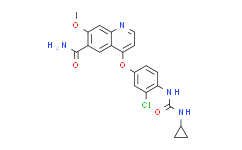| Cas No.: | 417716-92-8 |
| Chemical Name: | Lenvatinib free base |
| Synonyms: | 4-[3-Chloro-4-(cyclopropylaminocarbonyl)aminophenoxy]-7-methoxy-6-quinolinecarboxamide;lenvatinib;Lenvatinib (E7080);4-(3-Chloro-4-(3-cyclopropylureido)phenoxy)-7-methoxyquinoline-6-carboxamide;4-[3-chloro-4-(cyclopropylcarbamoylamino)phenoxy]-7-methoxyquinoline-6-carboxamide;E7080;E7080 (Lenvatinib);Lenvatinib E7080;E-7080;E7080,E 7080;Lenvima;E 7080;4-{3-Chloro-4-[(Cyclopropylcarbamoyl)amino]phenoxy}-7-Methoxyquinoline-6-Carboxamide;EE083865G2;AK175809;Lenv |
| SMILES: | ClC1C([H])=C(C([H])=C([H])C=1N([H])C(N([H])C1([H])C([H])([H])C1([H])[H])=O)OC1C([H])=C([H])N=C2C([H])=C(C(C(N([H])[H])=O)=C([H])C=12)OC([H])([H])[H] |
| Formula: | C21H19ClN4O4 |
| M.Wt: | 426.857 |
| Sotrage: | 2 years -20°C Powder, 2 weeks 4°C in DMSO, 6 months -80°C in DMSO |
| Description: | Lenvatinib is an oral, multi-targeted tyrosine kinase inhibitor with IC50s of 4 and 5.2 nM for VEGFR2(KDR) and VEGFR3(Flt-4), respectively. Lenvatinib is less potent against VEGFR1/Flt-1 and shows approximately 10-fold selectivity for VEGFR2/3 over FGFR1, PDGFRα/β. |
| In Vivo: | Lenvatinib inhibits the growth of H146 tumor at 30 and 100 mg/kg (BID, QDx21) in a dose-dependent manner and causes tumor regression at 100 mg/kg in H146 xenograft model. IHC analysis with anti-CD31 antibody shows that lenvatinib at 100 mg/kg decreases microvessel density more than anti-VEGF antibody and imatinib treatment[1]. lenvatinib (100 mg/kg, p.o.) is administeredand bevacizumab significantly inhibits local tumor growth at the m.f.p., and at the end of treatment, lenvatinib also significantly inhibits metastasis to both regional lymph nodes and distant lung[2]. |
| In Vitro: | Lenvatinib inhibits KIT kinase with an IC50 value of 100 nM. lenvatinib inhibits SCF- and VEGF-induced tube formation in a dose-dependent manner with IC50 values of 5.2 and 5.1 nM, respectively. Lenvatinib inhibits SCF-induced proliferation of another human SCLC, H526 cells, which expresses KIT, at the concentrations required for the inhibition of KIT kinase. The IC50 values of Lenvatinib against phosphorylation of KDR and KIT in HUVEC are about 500 times lower than those against H146 proliferation in vitro[1]. Lenvatinib inhibits both angiogenesis and lymphangiogenesis induced by human breast cancer cells, and significantly inhibits tumor growth of MDA-MB-231. Lenvatinib and bevacizumab treatment decreases MVD by almost the same extent[2]. Lenvatinib inhibits proliferation at high concentrations (mean IC50s 23.6-44.17 μM) in the majority of the cell lines, while the IC50 in the KM12C colon cancer cell line is 9.54 μM[3]. |

 DC Chemicals' products qualify for U.S. tariff exemptions. We guarantee no price increases due to customs duties and maintain stable supply, continuing to deliver reliable research solutions to our American clients.
DC Chemicals' products qualify for U.S. tariff exemptions. We guarantee no price increases due to customs duties and maintain stable supply, continuing to deliver reliable research solutions to our American clients.





















